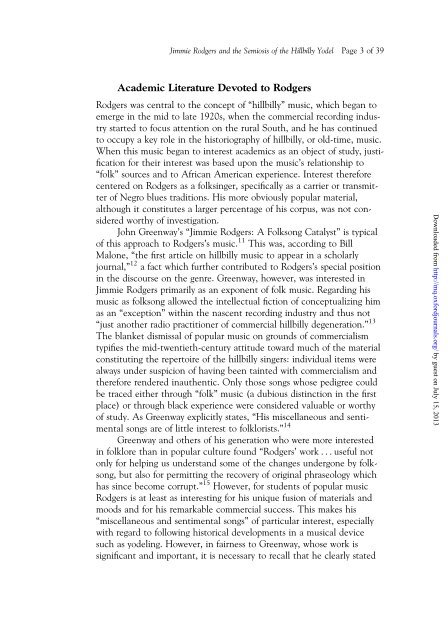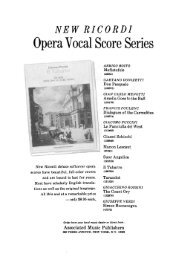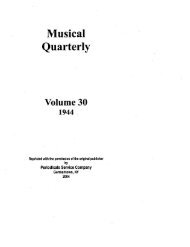Jimmie Rodgers and the Semiosis of the Hillbilly ... - Musical Quarterly
Jimmie Rodgers and the Semiosis of the Hillbilly ... - Musical Quarterly
Jimmie Rodgers and the Semiosis of the Hillbilly ... - Musical Quarterly
Create successful ePaper yourself
Turn your PDF publications into a flip-book with our unique Google optimized e-Paper software.
<strong>Jimmie</strong> <strong>Rodgers</strong> <strong>and</strong> <strong>the</strong> <strong>Semiosis</strong> <strong>of</strong> <strong>the</strong> <strong>Hillbilly</strong> Yodel Page 3 <strong>of</strong> 39<br />
Academic Literature Devoted to <strong>Rodgers</strong><br />
<strong>Rodgers</strong> was central to <strong>the</strong> concept <strong>of</strong> “hillbilly” music, which began to<br />
emerge in <strong>the</strong> mid to late 1920s, when <strong>the</strong> commercial recording industry<br />
started to focus attention on <strong>the</strong> rural South, <strong>and</strong> he has continued<br />
to occupy a key role in <strong>the</strong> historiography <strong>of</strong> hillbilly, or old-time, music.<br />
When this music began to interest academics as an object <strong>of</strong> study, justification<br />
for <strong>the</strong>ir interest was based upon <strong>the</strong> music’s relationship to<br />
“folk” sources <strong>and</strong> to African American experience. Interest <strong>the</strong>refore<br />
centered on <strong>Rodgers</strong> as a folksinger, specifically as a carrier or transmitter<br />
<strong>of</strong> Negro blues traditions. His more obviously popular material,<br />
although it constitutes a larger percentage <strong>of</strong> his corpus, was not considered<br />
worthy <strong>of</strong> investigation.<br />
John Greenway’s “<strong>Jimmie</strong> <strong>Rodgers</strong>: A Folksong Catalyst” is typical<br />
<strong>of</strong> this approach to <strong>Rodgers</strong>’s music. 11 This was, according to Bill<br />
Malone, “<strong>the</strong> first article on hillbilly music to appear in a scholarly<br />
journal,” 12 a fact which fur<strong>the</strong>r contributed to <strong>Rodgers</strong>’s special position<br />
in <strong>the</strong> discourse on <strong>the</strong> genre. Greenway, however, was interested in<br />
<strong>Jimmie</strong> <strong>Rodgers</strong> primarily as an exponent <strong>of</strong> folk music. Regarding his<br />
music as folksong allowed <strong>the</strong> intellectual fiction <strong>of</strong> conceptualizing him<br />
as an “exception” within <strong>the</strong> nascent recording industry <strong>and</strong> thus not<br />
“just ano<strong>the</strong>r radio practitioner <strong>of</strong> commercial hillbilly degeneration.” 13<br />
The blanket dismissal <strong>of</strong> popular music on grounds <strong>of</strong> commercialism<br />
typifies <strong>the</strong> mid-twentieth-century attitude toward much <strong>of</strong> <strong>the</strong> material<br />
constituting <strong>the</strong> repertoire <strong>of</strong> <strong>the</strong> hillbilly singers: individual items were<br />
always under suspicion <strong>of</strong> having been tainted with commercialism <strong>and</strong><br />
<strong>the</strong>refore rendered inau<strong>the</strong>ntic. Only those songs whose pedigree could<br />
be traced ei<strong>the</strong>r through “folk” music (a dubious distinction in <strong>the</strong> first<br />
place) or through black experience were considered valuable or worthy<br />
<strong>of</strong> study. As Greenway explicitly states, “His miscellaneous <strong>and</strong> sentimental<br />
songs are <strong>of</strong> little interest to folklorists.” 14<br />
Greenway <strong>and</strong> o<strong>the</strong>rs <strong>of</strong> his generation who were more interested<br />
in folklore than in popular culture found “<strong>Rodgers</strong>’ work ...useful not<br />
only for helping us underst<strong>and</strong> some <strong>of</strong> <strong>the</strong> changes undergone by folksong,<br />
but also for permitting <strong>the</strong> recovery <strong>of</strong> original phraseology which<br />
has since become corrupt.” 15 However, for students <strong>of</strong> popular music<br />
<strong>Rodgers</strong> is at least as interesting for his unique fusion <strong>of</strong> materials <strong>and</strong><br />
moods <strong>and</strong> for his remarkable commercial success. This makes his<br />
“miscellaneous <strong>and</strong> sentimental songs” <strong>of</strong> particular interest, especially<br />
with regard to following historical developments in a musical device<br />
such as yodeling. However, in fairness to Greenway, whose work is<br />
significant <strong>and</strong> important, it is necessary to recall that he clearly stated<br />
Downloaded from<br />
http://mq.oxfordjournals.org/ by guest on July 15, 2013







